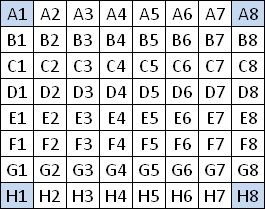
| Transformations and standard positions |
 |
 |
The standard position of unique SQ (or SM) is defined with the four corners: Condition 1: A1 < A8, H1, H8 (A1 has to be the smallest corner number) Condition 2: A8 < H1 Condition 1 can be fulfilled by rotations of the square. Condition 2 can be fulfilled by reflecting the square at the left main diagonal. (= swapping the coordinates x and y) |
 |
You can interchange any line x with the line (9-x). The picture shows the permutation of line 3 with line 6. In the notation of Benson and Jacoby: 1-2-6-4-5-3-7-8. Of course you can use any combination of these 4 simple permutations. There are 24 = 16 transformations of this type A. |
 |
You can apply any permutation to the lines 1,2,3,4. But you have to do the same with the lines 8,7,6,5. The picture shows the permutation 1-3-2-4-5-7-6-8. There are 4! = 24 transformations of this type B. |
 |
The standard position of ess. diff. SQ is defined with the entries of the two main diagonals: Condition 1: A1 is the smallest of all integers in the two main diagonals. Condition 2: B2 < G7, C3 < F6, D4 < E5 Condition 3: B2 < C3 < D4 Condition 4: A8 < H1 By magic transformations of type B you can move the smallest number into a corner. (4 possibilities) By rotations you can move the smallest number in the upper left corner. (4 possibilities) By magic transformations of type A you can fulfill condition 2. (23 = 8 possibilities) By magic transformations of type B you can fulfill condition 3. (3! = 6 possibilities) By reflection you can fulfill condition 4. (2 possibilities) |
 |
Our standard position of ess. diff. SM is not compatible with the standard position of unique magic squares: Condition 1: A1 = 64 (A1 is greater than any other integer in the square) Condition 2: A1 > A2 > A3 > A4 > A5 > A6 > A7 > A8 Condition 3: A1 > B1 > C1 > D1 > E1 > F1 > G1 > H1 Condition 4: A8 < H1 Possibilities: 64 x 7! x 7! x 2 = 8 x 406 425 600 |
| Back to Bimagic 8x8-Squares | Walter Trump, Nürnberg, Germany, (c) 2014-06-08, last update: 2015-05-09 |